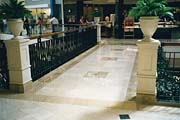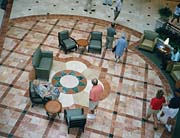
The developer and architects for The Mall at Wellington Green in West Palm Beach, FL, intended to build more than just a shopping center. They wanted to create a luxurious, upscale experience for its patrons. With that thought in mind, the design team thoroughly researched its ideas - a process that included a trip to Italy -- before setting to work on the project.
From the beginning, all those involved were in agreement about the overall design objective -- to give the appearance of the Mediterranean throughout the interior and exterior of the retail outlet. According to Sanjiv Bhandari, AIA, principal of BKBC Architects Inc. in San Francisco, CA, initial thoughts about the project surfaced more than 10 years ago. "We were working on this way back," he said. "Then we started to get serious about it. We spent some time visiting West Palm Beach, and then we took a trip to Italy."
The architect explained that his firm has had a working relationship with the developer, The Taubman Co. of Bloomfield Hills, MI, for many years. "They are in high-end retail projects all over the country," said Bhandari. "We have been working with them for the last 20 years."
After meeting with the executives of Wellington Green, it was confirmed that the aesthetics of the shopping center would reflect the style of the Mediterranean. As a result, the project team decided that a visit to Italy would be essential in creating an effective design.
"A group of about four or five of us went to Italy," said Bhandari. "We wanted to make an experience rather than just copying the architecture. We visited quarries and fabrication shops in Verona and Milan. It became evident to us that we wanted to stay true to the Mediterranean look and use natural materials. This was decided very early on in the design stage."

The stone palette
A substantial about of marble was employed throughout the interior of the two-level, 1.3 million-square-foot facility, which sits on a 111-acre lot as a focal point of the 466-acre Forest Hills Development Project. In total, The Mall at Wellington Green includes almost 490,000 square feet of retail space, which is anchored by department stores such as Dillard's, Nordstrom, Burdines, Lord & Taylor and JC Penney.An assortment of marble -- all supplied by Innovative Marble & Tile Inc. of Hauppauge, NY -- was chosen for the floor patterns to achieve a contemporary yet classic appearance, according to the architect. "The interplay of colors and patterns is greatly enhanced by the variation in the five types of marble selected," he said. "The final selection was made after much deliberation and review of numerous full-scale mock-ups."
With the exception of the food court areas, the main flooring in the public spaces consists of a field of Crema Torrino marble. In total, 85,000 square feet of this material was used.
"Given the large area of stone surface -- almost 150,000 square feet -- it was decided to select a marble type that does not vary tremendously in its texture and veining, while still providing enough drama and interest in the interior," said Bhandari. "In aiming to avoid long vistas of the similar materials, the mall was visually broken up by change of colors and patterns at every 100 to 150 feet."
The entire flooring, excluding the areas that feature waterjet-cut floor medallions, is comprised of 12- x 12-inch tiles, which are 1?inch thick. "We had a desire to use large-sized [tiles], but with the layout, it was not possible," said the architect. "So, we put accent keys of Attu marble -- a green color -- every 4 feet, which gave a larger tile feeling."
The medallions, which were all cut from 3?inch-thick marble slabs, were implemented in the design to add some color and liven the entry spaces, according to the design team. "We spent quite a bit of time designing the medallions," said Bhandari.
According to the architect, the design of the shopping center continually shifts. "No two lines in the mall are parallel," he said. "The 'street themes' are constantly changing throughout the mall." Bhandari explains that while certain areas are wide with higher ceilings, other parts, such as the seating lounges, become tighter areas with lower ceilings to create a more intimate atmosphere.
"In the court areas, we wanted to create a richer denser feeling," said Bhandari. "We wanted something that would make people stop and sit."
For these spaces, 20,000 square feet of Breccia Doris and 12,000 square feet of Mercato marble were used to form bands. "These two are subtle on a pinkish tone," said the architect. The design utilizes 2- x 2-foot modules to create a checkerboard pattern.
The pinkish shades of marble complement the Rose Kingdom marble, which was used for an information desk. The components were all custom-fabricated by Innovative Marble & Tile. The company also fabricated the border pieces, main field tiles and other cut-to-size pieces.
"We did all the shop drawings and shop tickets," said Rosalie Cipolla of Innovative Marble & Tile. "With fabricated pieces like the information desk, every piece has to fit together perfectly, therefore, a schematic/shop drawing is provided to the installer to facilitate installation."
Cipolla explained that due to the sheer volume of the stone used the project was extensive. "All of those pieces had to be coordinated from our factories in Spain, Turkey, Taiwan and Italy," she said. "Those coordinating efforts took about a four-month period."
Because the project was so involved, a variety of products from Laticrete[R] International, Inc. were used for the installation. For the marble floors, Laticrete[R] 220 Marble & Granite Mortar, Laticrete[R] 3701 Mortar Admix and Laticrete[R] 317 Floor N' Wall Thin-Set Mortar were used. Laticrete[R] 226 Thick Bed Mortar Mix was used to mud the depressions for the decorative medallions, while Latapoxy[R] 300 Epoxy Adhesives were used to install the green marble accents.
Additionally, Laticrete[R] 9235 Waterproof Membrane was used for a fountain in the Grand Court, and Laticrete[R] 310 Epoxy Adhesive was used to install the marble base on the stainless steel handrail shoe. Laticrete[R] 211 Crete Filler Powder and Laticrete[R] 86 Self Leveling Underlayment were also implemented in the installation, which was the work of Total Flooring Contractors, Inc. of Pompano Beach, FL.
"The Mall at Wellington Green was important to us because it gave the opportunity to work with an area developer that we had never worked with before," stated Bob Scavone Jr. of Total Flooring. "Though the project's work was very difficult, we improved our installation skills and knowledge because of it."
The installer explained that Total Flooring worked very closely with Laticrete. The product manufacturer was very "hands on" - assisting to conduct required compatibility tests. "Laticrete even helped invent new tests specifically for this project," stated Scavone. "It was a learning experience for everyone involved."
Exterior materials
Natural stone was also implemented for the design of the outside of the mall. Red sandstone was chosen to be consistent with the Mediterranean character of the shopping center as well as for its elegance, according to BKBC Architects."Sandstone was a very natural choice," said Bhandari. "We did look at several other stones, but we liked this best. We would have used it in more areas if cost wasn't an issue."
The 8-foot-high sandstone wall panels, which have a thickness of 2 feet, are designed to have natural cleft texture with deep reveals at the joints to express and highlight the variations inherent in the material. The shadow lines created by the reveals, especially in the strong Florida sun, further enhance the appearance of the sandstone.
"We decided to use the sandstone in selective areas such as the main entry," said Bhandari. The architect explained that the panels were made so large to take full advantage of the sunlight.
For the base of the building, a more permanent, water-resistant stone was needed. BKBC selected Sunset Red granite with a polished finish, which was supplied by Cold Spring Granite Co. of Cold Spring, MN. "It was an easy choice," said Bhandari. "The color came from the sandstone wall panels."
While design on the Mall at Wellington Green began in 1999, construction began in the spring of 2000. The shopping center opened its doors on October 5, 2001. "I had never felt this way before on Opening Day," said Bhandari. "From the mayor to the Taubman people to all the neighbors - everyone came and was very complementary."
